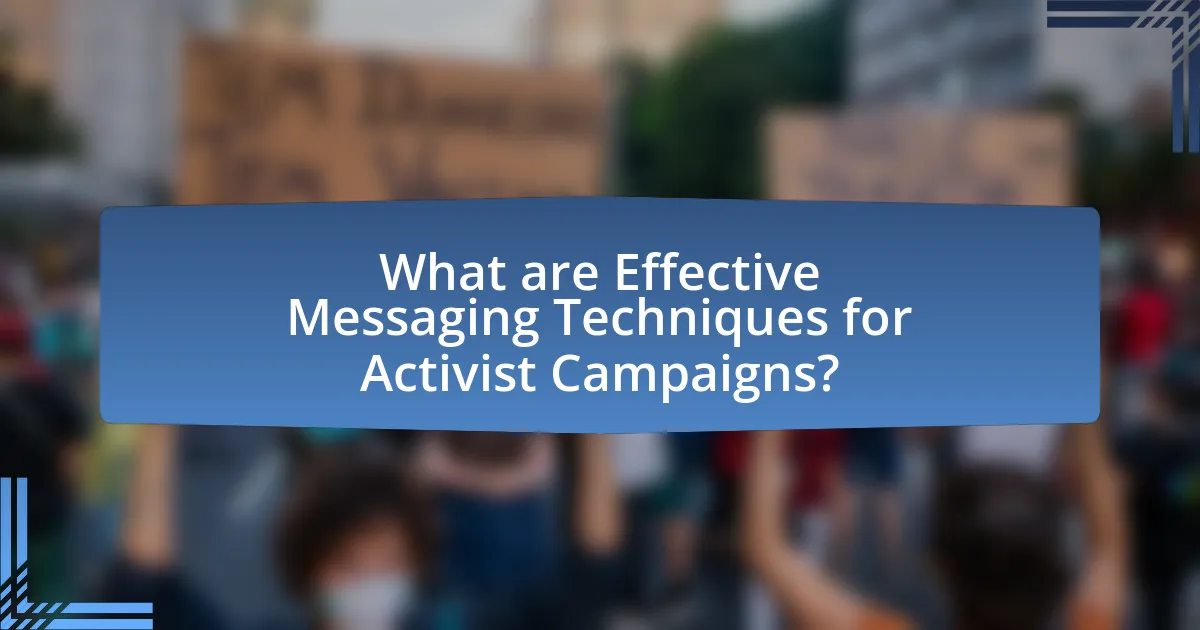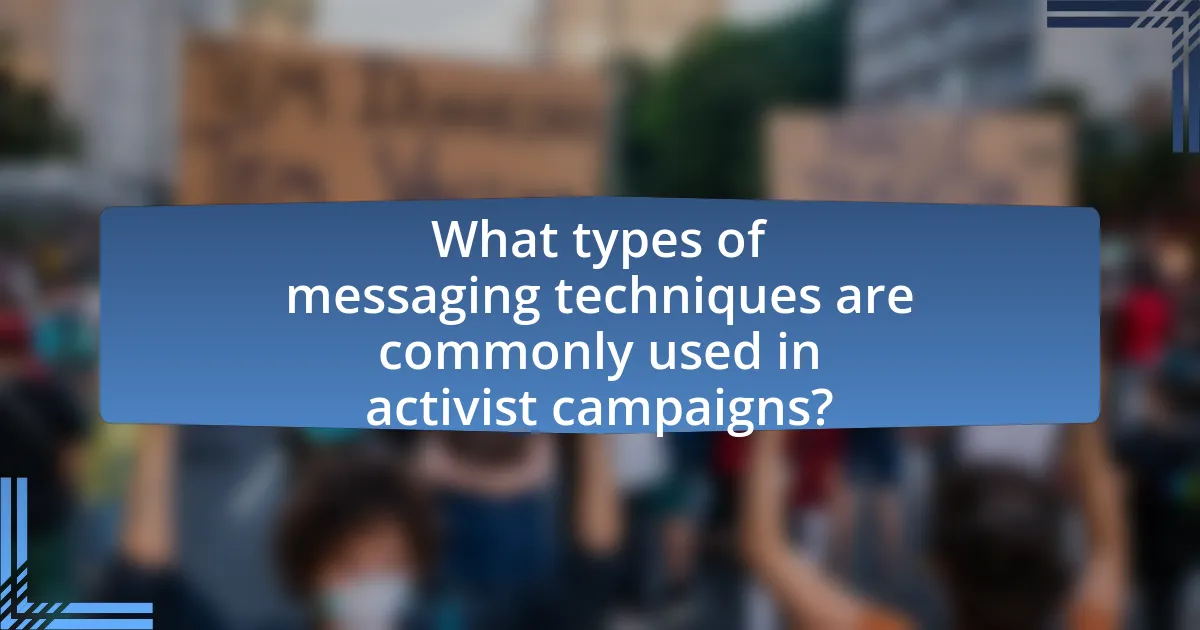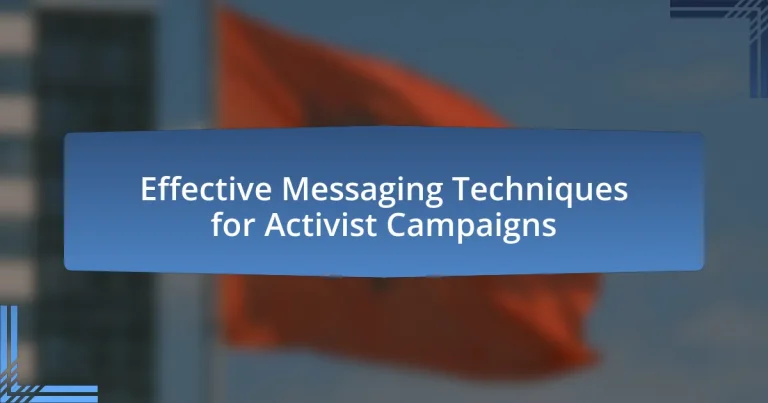Effective messaging techniques for activist campaigns are essential for mobilizing support and driving social change. Key elements include clarity, emotional appeal, storytelling, and audience targeting, which enhance understanding and engagement. The article explores how these techniques influence public perception, the importance of simplicity in communication, and the role of social media in amplifying messages. Additionally, it addresses challenges such as misinformation and audience apathy, providing practical tips for creating compelling calls to action and maintaining message consistency. By employing these strategies, activists can significantly improve the effectiveness of their campaigns.

What are Effective Messaging Techniques for Activist Campaigns?
Effective messaging techniques for activist campaigns include clarity, emotional appeal, storytelling, and audience targeting. Clarity ensures that the message is easily understood, which is crucial for mobilizing support; for instance, the “Black Lives Matter” movement effectively uses straightforward slogans to convey its message. Emotional appeal engages the audience on a personal level, as seen in campaigns like “It Gets Better,” which addresses LGBTQ+ youth by sharing personal stories of hope. Storytelling creates a narrative that resonates with the audience, making complex issues relatable; the “Me Too” movement utilized personal testimonies to highlight the prevalence of sexual harassment. Audience targeting involves tailoring messages to specific demographics to enhance relevance and impact, as demonstrated by environmental campaigns that focus on local issues to engage community members effectively. These techniques have been validated through successful campaigns that have led to significant social change.
How do messaging techniques influence activist campaigns?
Messaging techniques significantly influence activist campaigns by shaping public perception and mobilizing support. Effective messaging can create emotional connections, clarify the campaign’s goals, and enhance the urgency of the cause. For instance, the use of storytelling in campaigns like the Ice Bucket Challenge effectively raised awareness and funds for ALS by personalizing the issue, leading to over $115 million in donations in a single year. Additionally, concise and impactful slogans, such as “Black Lives Matter,” have galvanized movements by encapsulating complex social issues into memorable phrases, fostering widespread recognition and engagement. These techniques demonstrate that well-crafted messages can drive participation and amplify the reach of activist campaigns.
What are the key elements of effective messaging in activism?
The key elements of effective messaging in activism include clarity, emotional resonance, audience targeting, and a call to action. Clarity ensures that the message is easily understood, allowing the audience to grasp the core issue quickly. Emotional resonance engages the audience on a personal level, making them more likely to connect with the cause; for instance, campaigns that share personal stories often see higher engagement rates. Audience targeting involves tailoring the message to specific demographics, which increases relevance and impact; research shows that messages aligned with the values of the target group are more persuasive. Finally, a strong call to action motivates individuals to take specific steps, such as signing a petition or attending a rally, which is crucial for mobilizing support. These elements collectively enhance the effectiveness of activist messaging, as evidenced by successful campaigns like the Ice Bucket Challenge, which utilized all these strategies to raise awareness and funds for ALS.
How does audience understanding shape messaging strategies?
Audience understanding shapes messaging strategies by enabling tailored communication that resonates with specific groups. When activists analyze demographic data, cultural contexts, and psychological profiles, they can craft messages that align with the values and beliefs of their target audience. For instance, a study by the Pew Research Center found that messaging that reflects the audience’s concerns and language significantly increases engagement and response rates. This alignment not only enhances the effectiveness of the campaign but also fosters a sense of connection and urgency among the audience, ultimately driving action and support for the cause.
Why is clarity important in activist messaging?
Clarity is crucial in activist messaging because it ensures that the intended message is easily understood by the target audience. When messages are clear, they effectively convey the core issues and demands, which increases the likelihood of mobilizing support and action. Research indicates that clear messaging can enhance engagement; for instance, a study by the Stanford Social Innovation Review found that organizations with straightforward communication strategies are more successful in rallying public support. This demonstrates that clarity not only aids comprehension but also drives the effectiveness of activist campaigns.
What role does simplicity play in conveying messages?
Simplicity plays a crucial role in conveying messages by enhancing clarity and ensuring that the audience easily understands the intended communication. When messages are straightforward, they reduce cognitive load, allowing recipients to grasp key points quickly. Research indicates that simple messages are more memorable; for instance, a study published in the Journal of Communication found that audiences retain information better when it is presented in a clear and concise manner. This effectiveness is particularly vital in activist campaigns, where the goal is to mobilize support and inspire action. Therefore, employing simplicity in messaging not only facilitates comprehension but also increases the likelihood of engagement and response from the audience.
How can activists ensure their messages are easily understood?
Activists can ensure their messages are easily understood by using clear, concise language and avoiding jargon. Research indicates that messages with simple vocabulary and straightforward structure are more likely to resonate with a broader audience. For instance, a study published in the Journal of Communication found that clarity in messaging significantly increases audience engagement and comprehension. Additionally, utilizing visual aids, such as infographics, can enhance understanding by breaking down complex information into digestible formats.

What types of messaging techniques are commonly used in activist campaigns?
Activist campaigns commonly use techniques such as storytelling, emotional appeals, social proof, and calls to action. Storytelling engages audiences by presenting relatable narratives that highlight the issues at stake, making the cause more personal and impactful. Emotional appeals leverage feelings like empathy or anger to motivate individuals to support the cause, as seen in campaigns that use powerful imagery or testimonials. Social proof, such as showcasing endorsements from influential figures or community members, builds credibility and encourages participation by demonstrating widespread support. Calls to action provide clear, actionable steps for supporters, increasing engagement and mobilization. These techniques have been validated through various successful campaigns, such as the Ice Bucket Challenge, which effectively utilized emotional appeal and social proof to raise awareness and funds for ALS research.
How do emotional appeals enhance activist messaging?
Emotional appeals enhance activist messaging by creating a strong connection between the audience and the cause, which increases engagement and motivates action. Research indicates that messages invoking emotions such as empathy, anger, or hope can significantly influence individuals’ attitudes and behaviors. For instance, a study published in the journal “Psychological Science” found that emotionally charged narratives are more effective in persuading people than purely factual information, as they resonate on a personal level and prompt a sense of urgency. This emotional resonance can lead to higher levels of sharing and support for the cause, ultimately amplifying the impact of the activist message.
What are the most effective emotional triggers for audiences?
The most effective emotional triggers for audiences include fear, empathy, hope, and anger. Fear can motivate action by highlighting potential threats, as seen in public health campaigns that emphasize the dangers of smoking. Empathy engages audiences by fostering a connection to the experiences of others, often utilized in humanitarian efforts to encourage donations. Hope inspires positive action by presenting achievable solutions, which is common in environmental campaigns that showcase successful conservation efforts. Anger can drive mobilization against perceived injustices, as demonstrated in social movements that rally against inequality. These emotional triggers are supported by psychological research indicating that emotions significantly influence decision-making and behavior.
How can storytelling be utilized in activist messaging?
Storytelling can be utilized in activist messaging by creating emotional connections that resonate with audiences, thereby enhancing engagement and motivation for action. This technique allows activists to present complex issues in relatable narratives, making them more accessible and compelling. For instance, the use of personal stories in campaigns, such as those shared by organizations like Human Rights Campaign, has been shown to increase empathy and support for LGBTQ+ rights, as evidenced by studies indicating that narratives can shift public opinion more effectively than statistics alone.
What role does social media play in activist messaging?
Social media serves as a crucial platform for activist messaging by enabling rapid dissemination of information and fostering community engagement. It allows activists to reach a global audience instantly, facilitating the spread of campaigns, mobilization for events, and raising awareness about social issues. For instance, during the Arab Spring, social media platforms like Twitter and Facebook were instrumental in organizing protests and sharing real-time updates, demonstrating their power in shaping public discourse and action. Additionally, studies show that social media can increase participation in activism; a 2018 report by the Pew Research Center found that 69% of Americans believe social media is an effective tool for promoting social change.
How can activists leverage social media platforms for effective messaging?
Activists can leverage social media platforms for effective messaging by creating engaging content that resonates with their target audience. This involves using visually appealing graphics, concise messaging, and storytelling techniques to convey their message clearly and emotionally. Research indicates that posts with images receive 94% more views than text-only posts, highlighting the importance of visual content in capturing attention. Additionally, utilizing hashtags strategically can increase the visibility of their campaigns, as posts with at least one hashtag can increase engagement by 12.6%. By actively engaging with followers through comments and shares, activists can foster a sense of community and encourage further participation in their causes.
What are the best practices for crafting messages on social media?
The best practices for crafting messages on social media include clarity, engagement, and audience targeting. Clarity ensures that the message is easily understood, which is crucial for effective communication; studies show that concise messages increase user engagement by up to 60%. Engagement can be enhanced by using visuals and interactive content, as posts with images receive 94% more views than those without. Audience targeting involves tailoring messages to specific demographics, which can improve relevance and resonance; research indicates that personalized content can lead to a 20% increase in conversion rates.

How can activists measure the effectiveness of their messaging techniques?
Activists can measure the effectiveness of their messaging techniques through various quantitative and qualitative methods. Surveys and polls can provide direct feedback from the target audience regarding their understanding and perception of the messages. For instance, a study by the Pew Research Center found that 70% of respondents reported being influenced by social media campaigns, indicating that tracking engagement metrics such as shares, likes, and comments can also serve as a measure of effectiveness. Additionally, analyzing changes in public opinion or behavior before and after a campaign can provide concrete evidence of impact, as demonstrated in research published in the Journal of Communication, which highlighted that targeted messaging led to a 25% increase in awareness of social issues among participants.
What metrics should be used to evaluate messaging success?
To evaluate messaging success in activist campaigns, key metrics include engagement rates, conversion rates, reach, and sentiment analysis. Engagement rates measure how many individuals interact with the messaging, such as likes, shares, and comments, indicating the message’s resonance with the audience. Conversion rates track the percentage of individuals who take a desired action, such as signing a petition or donating, demonstrating the effectiveness of the messaging in prompting action. Reach quantifies the total number of individuals exposed to the message, providing insight into the campaign’s visibility. Sentiment analysis assesses the emotional tone of audience responses, revealing public perception and the overall impact of the messaging. These metrics collectively provide a comprehensive view of messaging effectiveness in achieving campaign goals.
How can feedback be gathered from the target audience?
Feedback can be gathered from the target audience through surveys, interviews, focus groups, and social media engagement. Surveys allow for quantitative data collection, while interviews and focus groups provide qualitative insights into audience perceptions and experiences. Social media engagement facilitates real-time feedback and interaction, enabling activists to gauge audience reactions and adapt messaging accordingly. Research indicates that 70% of organizations use surveys to collect feedback, highlighting their effectiveness in understanding audience needs and preferences.
What tools are available for analyzing messaging impact?
Tools available for analyzing messaging impact include social media analytics platforms, survey tools, and A/B testing software. Social media analytics platforms like Hootsuite and Sprout Social provide insights into engagement metrics, audience demographics, and sentiment analysis, allowing activists to gauge the effectiveness of their messaging. Survey tools such as SurveyMonkey and Google Forms enable the collection of direct feedback from target audiences, helping to assess message resonance. A/B testing software, like Optimizely, allows for experimentation with different messaging variations to determine which version yields better engagement and conversion rates. These tools collectively provide a comprehensive approach to understanding and optimizing messaging impact in activist campaigns.
What are some common challenges in activist messaging?
Common challenges in activist messaging include clarity, audience engagement, and misinformation. Clarity is crucial; messages must be straightforward to ensure understanding among diverse audiences. For instance, complex jargon can alienate potential supporters, reducing the effectiveness of the campaign. Audience engagement poses another challenge, as activists must tailor their messages to resonate with different demographics, which requires extensive research and adaptability. Misinformation can undermine campaigns, as false narratives spread rapidly, necessitating constant vigilance and fact-checking to maintain credibility. According to a study by the Pew Research Center, 64% of Americans believe misinformation is a major problem in political discourse, highlighting the importance of accurate messaging in activism.
How can activists overcome misinformation in their messaging?
Activists can overcome misinformation in their messaging by employing fact-checking, clear communication, and engaging with credible sources. Fact-checking allows activists to verify claims before dissemination, reducing the spread of false information. Clear communication ensures that messages are straightforward and easily understood, minimizing misinterpretation. Engaging with credible sources, such as experts or reputable organizations, provides authoritative backing to their claims, enhancing trustworthiness. Research indicates that campaigns utilizing these strategies are more effective in countering misinformation, as evidenced by a study published in the Journal of Communication, which found that fact-based messaging significantly improved public perception and understanding of complex issues.
What strategies can be employed to address audience apathy?
To address audience apathy, engaging storytelling and interactive content are effective strategies. Engaging storytelling captures attention by presenting relatable narratives that evoke emotions, making the message more memorable. For instance, research by the University of Pennsylvania found that narratives can increase information retention by up to 65%. Interactive content, such as polls or quizzes, encourages participation and fosters a sense of community, which can enhance emotional investment in the cause. A study published in the Journal of Marketing Research indicates that interactive experiences can increase audience engagement by 50%. These strategies effectively combat apathy by making the audience feel involved and emotionally connected to the message.
What practical tips can enhance messaging for activist campaigns?
To enhance messaging for activist campaigns, focus on clarity, emotional resonance, and audience engagement. Clear messaging ensures that the core message is easily understood, which is crucial for mobilizing support. Emotional resonance can be achieved by sharing personal stories or testimonials that illustrate the impact of the issue, making it relatable and compelling. Engaging the audience through interactive elements, such as social media polls or calls to action, fosters a sense of community and encourages participation. Research indicates that campaigns utilizing storytelling and emotional appeals can increase engagement rates by up to 50%, demonstrating the effectiveness of these strategies in activist messaging.
How can activists create compelling calls to action?
Activists can create compelling calls to action by using clear, concise language that emphasizes urgency and personal relevance. Effective calls to action often include specific, actionable steps that individuals can take, such as signing a petition, attending a rally, or donating to a cause. Research shows that messages framed with a sense of urgency, such as deadlines or limited opportunities, significantly increase engagement rates. For example, a study published in the Journal of Communication found that calls to action that included time-sensitive language resulted in a 30% higher response rate compared to those that did not. Additionally, incorporating emotional appeals and relatable narratives can enhance the connection with the audience, making them more likely to respond.
What are the best practices for maintaining message consistency?
The best practices for maintaining message consistency include establishing clear messaging guidelines, regularly training team members, and utilizing a centralized communication platform. Clear messaging guidelines ensure that all communications align with the core values and objectives of the campaign, which is crucial for maintaining a unified voice. Regular training sessions for team members reinforce these guidelines and help everyone understand the importance of consistency in messaging. A centralized communication platform facilitates easy access to approved messages and materials, reducing the risk of mixed messages. Research indicates that campaigns with consistent messaging are 20% more effective in engaging their audience, highlighting the importance of these practices in achieving campaign goals.


